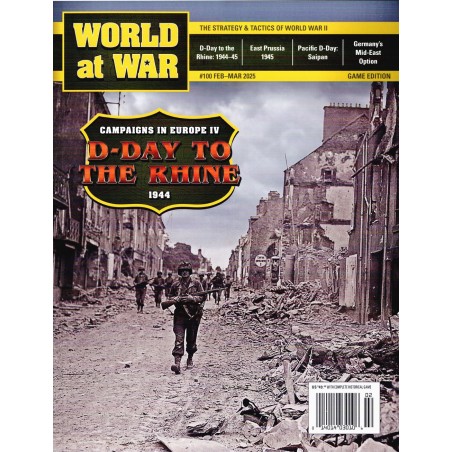







D-Day to the Rhine: 1944–45
Early in 1945, the armies of the Western Allies conducted a series of offensives that defeated the Germans in battles starting at the Rhine River and extending to the link up with the Soviets on the Elbe. Those offensives were the payoff of earlier strategic decisions as well as the logistical realities that shaped them.
 Security guarantees
Security guarantees
100% secure payments: PayPal, Visa, MasterCard, bank cards, alternative payments.
 Delivery policy
Delivery policy
Deliveries by Mondial Relay or Colissimo (French fast postal service).
 Returns policy
Returns policy
Returns accepted up to 14 days after delivery
Articles in the Magazine :
The Fall of East Prussia, 1945 The Red Army’s “East Prussia Offensive Operation” took place from January through April 1945. Conquering the heartland of the Prussian military aristocracy turned out to be one of the costliest and most bitterly contested campaigns fought by the Red Army since Stalingrad.
Pacific D-Day: Saipan, 15 June 1944 Though Allied victories in 1942/43 captured ground and inflicted staggering losses on the Japanese, their home islands remained beyond the reach of US bombers. In May 1944, however, a new plane—the B-29, with a range of almost 3,000 miles—became available. With the Mariana Islands—which included Saipan—just 1,260 miles from Tokyo, their strategic importance was suddenly highlighted. Victory there would secure bases from which B-29s could strike targets in the home islands.
Germany’s Middle East Option After the fall of France, Adolf Hitler had three strategic options to use to try to win the war. He soon gave up on the first—invading Britain—as impossible without air and naval supremacy. He eventually opted for the second—the ultimately disastrous, invasion of the USSR. The third option was an advance through the Balkans and Turkey into Iran. From there, German forces would have been in position to attack the Soviets from the south, or they could continue east to India in conjunction with a Japanese advance west from Burma.
The Game:
W100 D-Day to The Rhine 1944 (CIE Volume 4)
Campaigns in Europe (CIE) is a four-game series of two-player designs focused on campaign scenarios at the division/corps level. The system uses the same maps as War in Europe but with updated graphics and a more detailed terrain analysis. The counters have also been upgraded and are presented with their historic identifications. The system uses a Move/Fight, Fight/Move sequence to portray doctrinal differences among contending armed forces. It also uses headquarters units to project logistics and combat support capabilities.
D-Day to the Rhine covers the campaign in France from the Allied landing in Normandy through the drive to the Rhine. It ends at the completion of Operation Market Garden.
Each game turn (GT) represents around one week in clear weather and two weeks in mud and snow game turns. Each hex represents 20 miles (32.5 km) across. German, Finnish, and Western Allied units are shown mostly as division-sized units, with Soviet and Axis Allied units depicted as corps.
22 x 34-inch game map and a sheet of 280 1/2-inch counters.
Design by Joseph Miranda
You might also like